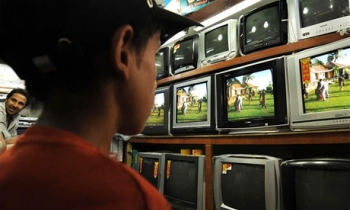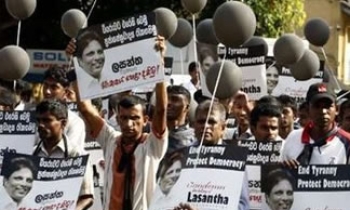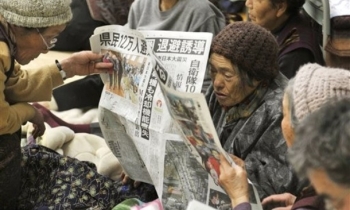NEW DELHI, September 12: It's time for some bad news for politics-centric newspapers. Indians prefer news about entertainment to that about current affairs. Worse, even sports is preferred more. Still worse, Indians prefer speed of news delivery to depth of analysis as far as news is concerned.
According to a study by leading global market research company, Synovate, 61 per cent consumers in India seek news about entertainment, 56 per cent sports, and 55 per cent current affairs. Politics as a distinct genre of news comes way behind with 38 per cent, followed by fashion (21 per cent), business (17 per cent), technology (13 per cent), finance (8 per cent), weather (7 per cent), and traffic (2 per cent).
The Synovate News Consumption Survey was conducted among more than 7,900 consumers from all socio-economic classes in China, Hong Kong, India, Singapore, Indonesia, Thailand and the Philippines in June this year.

Synovate Director of Media Research Asia Pacific, Steve Garton, said the survey provides a detailed look at consumers’ preferences for news media and content and the way in which news connects people to the broader community. "The Synovate News Consumption study shows that consumers enjoy a wide diet of news, from entertainment to current affairs, and source this information from a variety of media. Be it through new media like weblogs and mobile phones, or the traditional staples of television, newspaper and radio, keeping in touch is very important to Asian consumers and helps foster a sense of community," Garton said.
Consumers in Indonesia have a higher preference for entertainment news with 71 per cent. It is not that people of that country yearn more for entertainment the consumer preference for current affairs was higher still in fact, highest among the countries surveyed with as much as 87 per cent. Current affairs scored highest in other countries too Hong Kong (75 per cent), Thailand (71 per cent), Singapore (70 per cent), China (59 per cent), and the Philippines (54 per cent).

Entertainment was second ranked in all the countries that were surveyed Singapore (49 per cent), China (48 per cent), the Philippines (43 per cent), Hong Kong (38 per cent), Thailand (31 per cent). Entertainment was less than 50 per cent in all the countries apart from Indonesia and India.
The pattern remains almost the same for sports as well. The passion for sports news is much less than India (56 per cent) than in other countries Indonesia (43 per cent), Thailand (35 per cent), the Philippines (31 per cent), China (30 per cent). Singapore (29 per cent). Hong Kong (25 per cent). In this case, it is only in India that more than 50 per cent of news consumers follow sports news.
Politics is followed most in Thailand (56 per cent), and the least in Hong Kong (15 per cent). Business news is the highest in the Philippines (38 per cent), and the lowest in Hong Kong (3 per cent). Financial news, however, are the highest in Hong Kong (22 per cent) and the lowest in Indonesia (3 per cent). Fashion is the highest in China (24 per cent), and the lowest in Thailand (13 per cent). Weather is the highest in China (29 per cent), and the lowest in Indonesia (4 per cent).

But when a major disaster or news story breaks, which media do they turn to first for information? The response was an overwhelming 80 per cent in favour of television among all the countries surveyed with Indonesians (94 per cent) and Filipinos (92 per cent) relying on television the most, with Indians close behind with 88 per cent. The Internet as an alternative was the highest in China with 19 per cent. In India, 8 per cent depend on the Net for such news breaks.
Few people now seem to opt for more depth of analysis than speed of delivery. Indians are least concerned about depth of analysis two out of every three news consumer either strongly agree or just agree in favour of speed. Only 3 per cent believe in-depth news is of importance to them. The scene is not that bad in other countries, but even then 50 per cent across the region settle for speed than depth.
Respondents were asked how frequently, on average, they used different types of media for information on news or current affairs and revealed a surprising preference for traditional staples. "When investigating the types of media consumers use to access news, the importance of traditional means is clear with people continuing to turn to the media they know and are comfortable with for their news information," Garton said.

"The most popular news media is television, with 81 per cent of Asian consumers saying they tune into TV at least once a day for news and current affairs information. And despite talk about the impact of digital media, newspapers are the second most popular medium with 46 per cent of respondents across Asia reading a newspaper at least once a day for news information," Garton added.
While Singapore and Hong Kong are the region’s most avid newspaper readers with 67 per cent and 61 per cent of respondents respectively reading a newspaper at least once a day for news information, Indonesians (20 per cent) and Filipinos (28 per cent) remain glued to the television. Radio is the third most important source of news and current affairs information, especially in Hong Kong (37 per cent), Thailand (39 per cent) and Singapore (38 per cent) where more than one-third of respondents switch on their radios for news updates at least once a day," said Garton.

"But it’s not always TV anchors, columnists and talk back hosts who deliver the news, as the survey shows that family and friends also spread the word with 26 per cent of respondents using word of mouth at least once a day for information on news and current affairs."
While digital media still lags behind traditional means, its popularity is growing with 19 per cent of respondents using the Internet for information on news and current affairs between once a day and two to three times a week. In countries with high Internet penetration rates like Hong Kong and Singapore, 25 per cent of the population now use the Internet to access news and current affairs on a daily basis.
Synovate also asked respondents a number of statements to determine their attitudes to a wide range of media issues and when it comes to trusting the news, it seems to be a matter of country rather than the heart. Across the region, an average of 58 per cent of respondents agreed with the statement I trust a lot of the news stories I see or hear’, with results differing greatly between countries.

Thais are the most cynical news consumers regionally with only 26 per cent of respondents agreeing that they trust the news, followed by Chinese residents in major cities (44 per cent) and Filipinos (42 per cent). At the other end of the spectrum, a majority of Indians (77 per cent) and Indonesians (74 per cent) trust a lot of the news stories they see or hear.
"When trying to understand why people watch, read and listen to the news, it’s clear that a feeling of belonging is important to people, with 70 per cent of respondents agreeing with the statement that they like to keep in touch with the news as it makes them feel part of the community," Garton said. News also serves a practical purpose, with six in 10 respondents across Asia agreeing that keeping in touch with the news is important for their career success. Indians (71 per cent), Filipinos (68 per cent) and Thais (67 per cent) are the strongest believers that news and career success go hand in hand while only 32 per cent of respondents in Hong Kong agree that keeping up with the news is important for their work.

"The biggest development in digital news is the emergence of personal online diaries better known as blogs and across the region over one in 10 respondents had gone online to access a weblog for news information in the past week," Garton said. "In some countries this rate is even higher, with 31 per cent of respondents in Thailand, 22 per cent of respondents in China and 19 per cent of respondents in Hong Kong indicating that they had read a weblog for news information in the past week."
Mobile phones are also emerging media for news and current affairs in China and Thailand where 18 per cent and 16 per cent of respondents respectively had received news or headlines on their mobile phone in the past week. However, adoption in other countries remains relatively low. When it comes to the long running debate over subscription based news websites, only 4 per cent of respondents across all the countries had accessed a news website for which they had paid to subscribe. Respondents from Singapore (9 per cent), Hong Kong (8 per cent) and China (7 per cent) were more likely to have accessed a paid news website.









